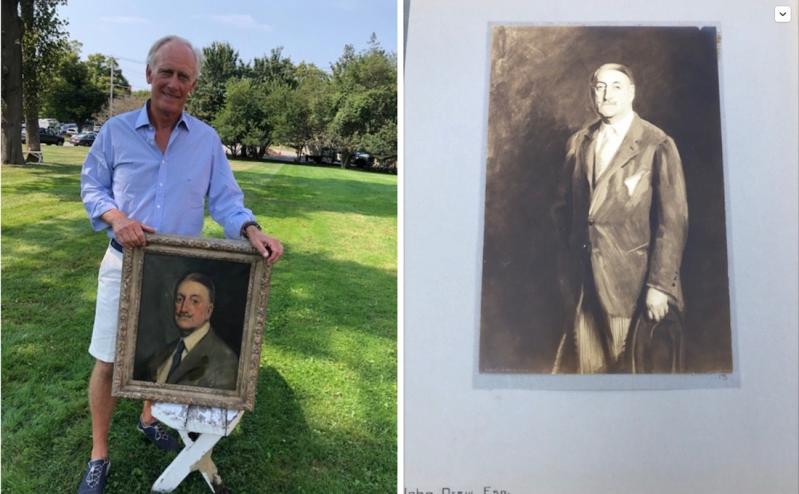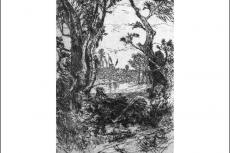In 1923, Albert Delmont Smith, a wealthy and well-connected artist who kept a summer studio in one of the old Sea Spray Inn cottages near Main Beach, painted a portrait of the actor John Drew. Before long, it was decided that the picture of the matinee idol, a longtime East Hampton second-home owner who was universally lionized by the community, should be purchased and presented to the village.
More than 100 donors, year-round and summer colony residents both (Childe Hassam, P.G. Wodehouse, and Lion Gardiner among them), contributed to the purchase fund. "The portrait, which Mr. Smith considers among his most successful, is a three-quarter-length canvas," The East Hampton Star reported. "It presents Mr. Drew in an easy, characteristic pose. Those who have seen the picture in the studio say that it is not only a good likeness of Mr. Drew but a fine specimen of Mr. Smith's sound and correct style of portraiture."
On the evening of Sept. 28, 1923, in Clinton Academy, a formal ceremony of presentation was held.
Just four days later, a puzzling piece of business occurred at the monthly meeting of the East Hampton Village Board. According to the village archives, "A motion was made and carried that the Drew Painting be loaned to Albert D. Smith for a period of sixty days for exhibition purposes, upon his guarantee of its safe return."
If the trustees wondered why Smith wanted his painting back so soon after the village had taken ownership of it, they did not say, not for posterity anyway. A pity, in view of what happened next.
The 60 days agreed upon for an "exhibition" had not quite gone by when, according to the minutes of Nov. 20, "There was considerable discussion on the matter of the removal of the John Drew oil painting for exhibition, by Albert D. Smith, and the correspondence concerning same was read."
Period, end of paragraph. Correspondence? Between whom? Discussion? About what? We will never know. All we know is that East Hampton Village, inexplicably, seems never to have inquired further into its missing portrait of John Drew.
Hugh King, director of the village's Home, Sweet Home Museum, has been puzzling over its whereabouts for decades without success. There is a well-known portrait of John Drew that has hung at Guild Hall since its founding in 1931, but that painting is by James Montgomery Flagg.
As for Albert Delmont Smith, so far as this small corner of the world is concerned, he never existed. The East Hampton Library's Long Island Collection, a 100,000-plus-documents arsenal of local information, has no record of him. "I regret to report that all of my searching is yielding nothing on Albert Delmont Smith in our collections," the collection's head, Andrea Meyer, told Mr. King.
Guild Hall knows nothing of an Albert Delmont Smith either. In 1979, the Heckscher Museum of Art in Huntington asked to borrow the Drew portrait for an exhibition. "I regret to say we do not have a work by this painter in our collection," replied Enez Whipple, Guild Hall's longtime director.
The East Hampton Historical Society's former executive director Richard Barons, now chief curator, has searched its archives and come up equally empty-handed.
Yet Smith, who shared a studio one summer with Childe Hassam; who married a daughter of Henry Lee (the Lee of Lee Avenue), and who "made numerous depictions of Montauk and the East End of Long Island," according to "The Encyclopedia of American Biography," went on in later life to have a distinguished career both as a portraitist and as an art historian. In the 1940s and '50s he became curator of the Heckscher Museum of Art, and transformed a stodgy institution that had displayed the same works on the same walls since its founding into a well-regarded modern museum with rotating shows. His "beneficial public and private connections enabled him to obtain loans of outstanding objects from major collections," says his encyclopedia entry.
The Heckscher, then, was the logical place to begin the search. An emailed inquiry to its director, Michael Schantz, brought an immediate response: The museum would be happy to help. Its offices and warehouse were closed for the pandemic, but its chief curator, Karli Wurzelbacher, would be in touch.
"I don't see why he would have wanted to keep the painting," Ms. Wurzelbacher said in an early telephone interview. She suggested there had been "an honest mistake" somewhere along the line, emphasizing that Smith had been "very much a social equal" with Hasssam, Lee, and John Drew himself.
"I don't think he'd have tried to rip off his golfing friends, or had any motivation," she said. Perhaps the problematic loan had been for "a general provision rather than a specific show? For any exhibition purposes that might arise? Probably if he ever needed it, they would make it a condition of the sale, or even just a gentleman's agreement."
Toward the end of the conversation the curator mentioned that the artist's grandson, John, was alive and well and living on the North Shore. Not only that, but his mother, Mariana, now 90, lives in Florida.
John C. Smith, who sounded delighted to hear that his grandfather's legacy was being explored in East Hampton, inherited almost all of Albert Delmont Smith's paintings (some are in museums), and has them, on the walls or stored below, in his house in Locust Valley. (His mother said that in 1983, after his father died, John — the oldest of their four children and the only boy — "pretty much got everything. It was a very masculine thing.")
Mr. Smith was intrigued to hear about the village's lost John Drew. Why, yes, he emailed, he did indeed have such a portrait, and would send a photograph of it later that day, "No idea how we ended up with this painting, but I remember it being in the house growing up," he wrote, adding, "I would be happy to donate the painting if they are interested."
Ecstasy! As easily as that, the quest appeared to be over, the puzzle solved, the portrait found. Hugh King almost jumped out of his stovepipe hat.
"Dear John C. Smith: What a wonderful way to start the week!!"
"Dear Michael Schantz: We are absolutely shocked, stunned, and thrilled . . . a thousand thanks. . . ."
But not so fast.
Upon receipt of the photo, which shows an elaborately framed head-and-shoulders image of the actor, and a look back at The Star's description of the "recently completed" picture presented to the village in 1923, it was pretty clear that they could not be one and the same. This one, dated 1917, was a bust; the missing one, a "three-quarter-length canvas."
Albert D. Smith had painted not one portrait of his friend John Drew, but two.
Agony!
But wait. Mr. Smith, when told of this discouraging development, was undiscouraged. He went searching through his storeroom and came up this time with an image of a second painting, dated 1923 (possibly 1922) that perfectly matches the account in The Star. Should there be any doubt, at the bottom of the image, in the artist's own handwriting, it says: "John Drew Esq. In Guild Hall, a memorial to John Drew at East Hampton."
Ecstasy!
"We thought forever it was at Guild Hall," Mr. Smith said. His mother agreed. Her father-in-law, she said, "told me, 'My painting is in the theater.' "
Nothing now remained but to arrange a triumphant photo session with a beaming Mr. Smith holding up the long-lost portrait. Just for fun, he was asked to bring along both John Drews.
But no. There had been a sad misunderstanding, he explained. What he'd found in the storeroom was not the actual painting but his grandfather's vast portfolio containing images of almost his entire oeuvre; many, like this one, with dates and notations in his hand.
Agony.
Albert Delmont Smith died in 1963. The missing portrait is still missing. We may never find it, or understand why the artist took it back, if indeed he did, so soon after it was presented to the village. But at least — at last — we know what it looks like.




